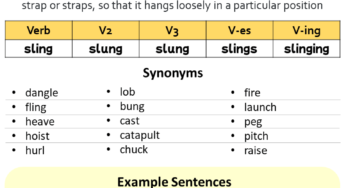Sling Past And Past Participle Form V1 V2 V3 V4 V5 Form of Sling
If you’ve ever found yourself in a grammar pickle, you’re not alone. English can be tricky, especially when it comes to verbs.
Take the word “sling,” for example. It’s a simple word with multiple forms that can leave you scratching your head. Whether you’re writing an essay, crafting a story, or just want to boost your English skills, understanding the past and past participle forms of “sling” is key.
Dive into this guide where we’ll unravel the mystery behind its V1, V2, V3, V4, and V5 forms. We’ll make it easy and engaging, so you can confidently use “sling” in any tense. Get ready to enhance your language prowess and clear up any confusion you might have. Your command of English is about to get a whole lot stronger!

Credit: englishgrammarhere.com
Sling Verb Forms
The verb “sling” is used in many contexts. Its base form is “sling”. In the past tense, it becomes “slung”. The past participle is also “slung”. Use these forms in different sentences. They help express actions correctly. Let’s look at the other forms too.
| Form | Example |
|---|---|
| V1 | sling |
| V2 | slung |
| V3 | slung |
| V4 | slinging |
| V5 | slings |
These forms help in writing and speaking. They make sentences clear. Practice using these forms in your daily language. It will help you improve.

Credit: englishstudyhere.com
Usage Of Sling In Sentences
The word slingcan be used in different ways. The present form is sling. In the past, it becomes slung. Its past participle is also slung. The present participle form is slinging. In the future, we say will sling.
Sentences help us understand its use. “She slingher bag over her shoulder.” In the past, we say, “He slungthe rope.” Using it in the present participle, “They are slingingstones.” For future use, “I will slingit later.”
Common Mistakes With Sling Forms
Many people mix up the forms of sling. They often use the wrong verb form in sentences. The present form is sling. The past form is slung. The past participle form is also slung. Mistakes happen with these forms.
Some say “slang” for the past. Others use “slinged” wrongly. These are not correct forms. Using the right form is important. It makes sentences clear and correct.
- Use “sling” for present actions.
- Use “slung” for past actions.
- Use “slung” for past participle forms.
- Check verb forms before writing.

Credit: www.pinterest.com
Conclusion
Learning different forms of “sling” helps in mastering English verbs. The verb “sling” changes with tense, enhancing language skills. Practice makes perfect. Regular use ensures better understanding and communication. Knowing V1 to V5 forms aids in sentence construction. This knowledge boosts confidence in speaking and writing.
Mistakes will decrease over time. Continuous learning is key. Verbs are the backbone of language. Progress happens with patience and practice. Keep exploring new words and their forms. Language is a journey, not a destination. Enjoy the process and keep improving your English skills.






